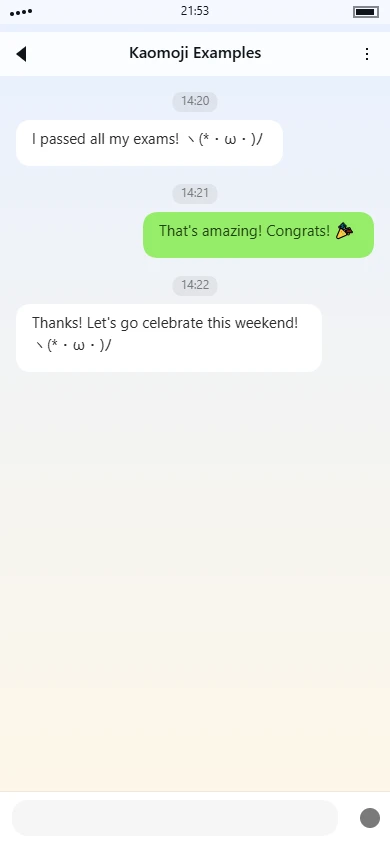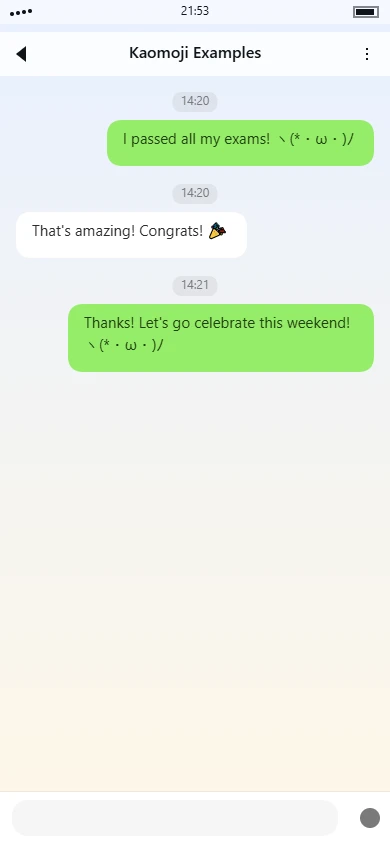(´• ω •`) kaomoji Meaning | Usage Tips

Overview
The kaomoji
(´• ω •The character arrangement follows a symmetrical pattern, with the left and right sides mirroring each other in structure. The use of accented characters adds slight visual complexity without overwhelming the simple composition. The kaomoji maintains readability across different text environments while conveying a specific emotional tone through its carefully chosen symbols.
Symbol Breakdown
-
Parentheses
(
: These curved brackets form the outer boundary of the face, creating a rounded shape that suggests a friendly, approachable appearance. The curvature helps establish the facial contour without sharp edges.) -
Accented apostrophes
: Positioned before the dot characters, these accents add a slight upward tilt to the eyes, contributing to the expression's gentle quality. The accents create visual interest while maintaining simplicity.´ -
Middle dots
: These solid dots serve as the main eye elements, providing clear focal points within the composition. Their circular shape and solid fill give them good visibility against most backgrounds.• -
Space character: The space between the eyes and mouth area helps separate facial features clearly, preventing visual clutter and improving readability of the expression.
-
Greek letter omega
: This character forms the mouth element, with its curved shape suggesting a small, content smile. The omega's natural curvature fits well within the facial structure.ω
Emotion & Aesthetic Analysis
The emotional tone conveyed by this kaomoji leans toward gentle contentment with a touch of innocence. The combination of slightly upturned eyes and the subtle omega-shaped mouth creates an expression that could be interpreted as pleased, satisfied, or quietly happy. The overall effect is softer than more exaggerated smiling kaomoji, making it suitable for situations requiring mild positive reinforcement rather than enthusiastic celebration.
In terms of aesthetic qualities, the kaomoji employs a balanced approach to character selection. The mix of standard punctuation, spacing, and a Greek letter creates visual variety while maintaining coherence. The composition avoids extreme stylization, positioning it as a versatile expression that works across different communication contexts. Compared to similar kaomoji, this version uses accented characters for the eyes rather than simple dots or other symbols, giving it a slightly more refined appearance while preserving accessibility.
Tag categories
Use tags to quickly understand this kaomoji.
Usage guide
Usage Guide for (´• ω •`)
This gentle, slightly bashful kaomoji captures a unique blend of innocence and contentment, making it a versatile tool for online communication. With its rounded eyes and soft mouth shape, it conveys a sense of sweet embarrassment, quiet satisfaction, or playful shyness that works well across various digital platforms. The expression sits somewhere between a blush and a contented smile, perfect for moments when you want to soften your message or add a touch of endearing vulnerability. You'll often see it used in casual chats, social media comments, gaming communities, and friend groups where a lighthearted, non-threatening tone is appreciated.
Common Use Cases
- When admitting a small mistake or oversight in a group chat
- Reacting to receiving unexpected but pleasant attention or compliments
- Expressing quiet satisfaction after completing a simple task
- Responding to teasing from friends in a good-natured way
- Showing appreciation for cute animal photos or heartwarming content
- When sharing a personal achievement without sounding boastful
- In gaming chats after narrowly winning or receiving helpful items
- Reacting to romantic or sweet messages from a partner
- When asking for a small favor from close friends
- Expressing gentle surprise at discovering something interesting
- Responding to food pictures that look particularly delicious
- When sharing nostalgic memories with childhood friends
Example Conversations
-
Friend chat about weekend plans A: "Hey, I accidentally bought tickets for the wrong movie date" B: "No worries! We can just go next week instead (´• ω •`)"
-
Social media comment exchange A: "Just finished baking cookies for the first time! They're a bit lumpy but taste okay" B: "Aww they look adorable! Bet they're delicious (´• ω •`)"
-
Gaming team coordination A: "Sorry guys, I messed up that last combo" B: "It's cool, we still won! You did great overall (´• ω •`)"
-
Relationship messaging A: "I was thinking about you all day at work" B: "That's so sweet... me too (´• ω •`)"
-
Workplace casual chat A: "Thanks for covering my shift last minute!" B: "No problem at all, happy to help (´• ω •`)"
-
Family group chat A: "Remember when we used to build pillow forts as kids?" B: "Those were the best times (´• ω •`) miss those days"
Important Notes
- Avoid using this kaomoji in formal emails, professional correspondence, or serious discussions where its playful tone might undermine your message's importance
- The expression carries a distinctly gentle, almost childlike quality that may not translate well in conversations requiring assertiveness or authority
- In some cultural contexts, the kaomoji's shy demeanor might be misinterpreted as lack of confidence rather than endearing humility, so consider your audience carefully
- While it works well across most social platforms, it's particularly common in anime/manga communities and gaming spaces where cute expressions are widely appreciated
- The kaomoji's effectiveness relies on the surrounding context - it enhances friendly conversations but can feel out of place in debates or confrontational exchanges
- Remember that tone doesn't always translate perfectly across languages and cultures, so when communicating with international friends, ensure the overall message supports the kaomoji's intended gentle, positive vibe
Usage examples
Real conversation samples that feature this kaomoji.

Example 1

Example 2
Related kaomoji
You might also enjoy these kaomoji.